بصفتك شركة ناجحة، فإن أهم أصولك هم موظفوك. لا شك أنك تريد أفضل برنامج مكافآت للموظفين لموظفيك.
يجب عليك اختيار برنامج مكافآت الموظفين الذي يساعد على تعزيز القيم الأساسية لشركتك ويعزز العلاقات الصحية بينك وبين موظفيك.
إن برنامج المكافآت أشبه بدورة حميدة. عندما يشعر الموظفون بالتقدير، فإنهم يرون الفوائد المباشرة لعملهم الشاق، ويحصل عملك على الاحتفاظ بالمواهب في شركتك، وتحظى الشركة بفرصة أفضل للتفوق على المنافسين.
سواءً كان الأمر يتعلق بفهم سبب أهمية برنامج المكافآت أو كيفية إعداده، فنحن نوفر لك كل ما تحتاج إليه. نحن نقدم عملية خطوة بخطوة لإنشاء برامج مكافآت وتقدير الموظفين باستخدام ClickUp وأفضل النماذج لمراجعات الأداء.
ما هي برامج مكافآت الموظفين؟
برنامج مكافآت الموظفين هو إطار عمل لتقدير أداء الموظفين ومساهماتهم ويهدف إلى مكافأتهم وتحفيزهم. برنامج المكافآت منفصل عن الراتب ويتكون من مكافآت نقدية أو غير نقدية لإلهام الفريق لتقديم أداء أفضل.
تخيّل أن مدير مشروعك قام بتسليم مشروع الربع الرابع لأحد أكبر عملائك في الخارج قبل الجدول الزمني المحدد وتجاوز التوقعات في نفس الوقت.
يعتبر تكريم هذا الفوز ببطاقات هدايا مرغوبة أو تقديم وصول حصري لفرص التطوير المهني مكافأة للموظفين.
يهدف نظام مكافأة الموظفين إلى تحفيز أعضاء الفريق وإنشاء بيئة عمل تعترف فيها الشركة بالموظفين ذوي الأداء الجيد وتحتفي بهم أداء العمل بحوافز ذات مغزى. هذا يبني ثقافة التميز ويعزز معنويات موظفيك لتحقيق نتائج رائعة باستمرار.
يجب أن تكون نقطة الانطلاق بالنسبة لقسم الموارد البشرية لديك هي تصميم برنامج لتقدير الموظفين يتوافق مع القيم الأساسية لشركتك. كن واضحًا بشأن السلوك الذي تريد مكافأته وكيف ولماذا.
على سبيل المثال، إذا كان اتباع نهج تخريبي أمرًا حاسمًا للنجاح المستقبلي، فاحرص على أن يتم تقدير الموظفين على ذلك بمكافأة غير مالية أو نقدية.
## الفرق بين مكافآت الموظفين وبرامج تقدير الموظفين
قبل أن نذهب إلى أبعد من ذلك، دعنا نكون واضحين: المكافآت والتقدير ليسا متماثلين. عندما تستخدم كلتا الكلمتين في جملة، فلكل منهما معنى مختلف، ولكن الهدف النهائي واحد.
أي شكل من أشكال التقدير الاجتماعي الذي يعترف ويقدر جهود الموظف هو تقدير للموظف وليس مكافأة للموظف. على سبيل المثال، عندما تشيد بجهود أحد الموظفين في اجتماع الفريق أو تمنحه لقب "موظف الشهر".
ما لم يتم إرفاق فائدة ملموسة مثل الحوافز المالية مع الثناء، فإنه لا يعتبر مكافأة للموظف. ومع ذلك، إذا كنت تريد الأفضل من موظفيك، فإن برنامج المكافآت التنافسية سيحقق لك ذلك، حيث من المرجح أن يزيد من أداء الموظفين بقدر 27% .
أهمية وجود برامج مكافآت الموظفين ## ## أهمية وجود برامج مكافآت الموظفين
الموظفون السعداء والمتحمسون يجعلون المؤسسة ناجحة. ويساعد برنامج مكافآت الموظفين على بناء مكان عمل يعترف فيه الموظفون بجهودهم ويحتفل بإنجازاتهم ويشعر كل عضو في الفريق بأهميته.
هذه نظرة مبسطة لدور مكافآت الموظفين في مكان العمل. دعونا نلاحظ لماذا تعتبر مثل هذه البرامج جزءًا لا يتجزأ من تنمية قوة عاملة مزدهرة ومتحمسة.
تعزز معنويات الموظفين
يقضي الموظفون 40 ساعة على الأقل أسبوعيًا في مكان العمل. وتلعب الروح المعنوية في مكان العمل دورًا كبيرًا في أدائهم.
فإذا لم يتم الاعتراف بعملهم وعدم تقديرهم من قبل قادة الفريق أو عدم تقديرهم لعملهم، فسوف ترى تأثيرًا مباشرًا على إنتاجيتهم. والجزء الأسوأ هو أن الموظفين الآخرين يفقدون الحافز عندما يرون زملاءهم غير راضين أو منهكين.
إن إعداد برنامج للمكافآت والتقدير يعزز معنويات الموظفين. يشعر موظفوك بالتقدير والتقدير. كما أنهم يحصلون على إحساس بالإنجاز بأنهم يساهمون في شيء جدير بالاهتمام.
ومن المثير للاهتمام، أن المكافآت غير النقدية مثل الرسائل الشخصية أو أي شكل من أشكال المكافآت الشخصية قد يحسن من معنويات الموظفين.
تشجع بيئة العمل الإيجابية
يعد تقدير الأقران حافزًا قويًا لبناء ثقافة إيجابية للشركة. من الاحتفال بإنجازات الفريق إلى الإنجازات الفردية الأسبوعية، قم بإنشاء شكل من أشكال برنامج مكافآت الموظفين. اعتبر برنامج التقدير حجر الزاوية الأساسي في ثقافة مؤسستك.
المفتاح هنا هو جعل البرنامج شاملاً. اطلب من المديرين والقادة أن يكونوا فاعلين في مشاركتهم وتقديرهم لعمل موظفيهم. يمكن أن يكون ذلك بسيطًا مثل إضافة "جائزة اختيار القادة" الخاصة لتكريم الموظفين الذين يقدمون الأفكار الأكثر ابتكارًا.
يعد تقدير الأقران جانبًا آخر غالبًا ما يتم إغفاله في أنظمة مكافأة الموظفين. إن إشراك زملاء الفريق في الإعجاب بعمل بعضهم البعض يبني روحًا تعاونية على المدى الطويل. ويدعم أعضاء الفريق بعضهم البعض عن طيب خاطر لتقديم أداء أفضل، مما يجعل عمل الجميع سهلاً.
يحسن الاحتفاظ بالموظفين
خلال الجائحة، أدرك الموظفون في العديد من القطاعات أنهم غير راضين عن وظائفهم الحالية. وقد أدى ذلك إلى الاستقالة الكبرى - أي النزوح الجماعي للموظفين من الوظائف والمهن التي لم يعودوا يرغبون في متابعتها.
ما يعنيه هذا بالنسبة لمؤسستك هو أنه إذا كان مستوى التحفيز لدى موظفيك منخفضًا، فإنك تدفعهم إلى قبول عروض عمل جديدة.
سيكون برنامج مكافآت الموظفين المنظم جيدًا عائقًا في مثل هذه الحالة. إن أفضل طريقة لاستخدام المكافآت للاحتفاظ بالموظفين المستحقين هي أن تقدم لهم خطة تطوير وظيفي مصممة خصيصًا لتناسب اهتماماتهم. إذا لم يكن ذلك ممكناً، فإن ورش العمل وبرامج التطوير المهني المعتمدة هي مكان رائع للبدء.
وتتمثل ميزة برامج المكافآت هذه في أن موظفيك سيتوقعون فائدة البقاء مخلصين لشركتك. وهذا يتجاوز مجرد مكافأة الموظفين لأنه يعترف بالتطلعات الفردية ويستثمر في نموهم الوظيفي على المدى الطويل.
بدون مثل هذه المكافآت تحسين أداء العمل ، فإن أفضل المواهب لديك ستفكر في نهاية المطاف في ترك الشركة مع عدم وضوح مسار نموهم الشخصي.
يعزز مشاركة الموظفين
الموظفون المنفصلون في مكان العمل يكلفونك المال - الكثير من المال. فهم أقل إبداعًا. وبالتالي، فإن إنتاجيتهم في العمل تكون أقل، مما يعني أن إنتاجك يتضرر. إذا استمرت دوافع الموظفين منخفضة، فيجب استبدالهم، مما يزيد من تكاليف دوران الموظفين.
وفقًا لـ غالوب أن الموظفين المنخرطين في العمل يزيدون من الربحية بنسبة 21% ويكونون أكثر إنتاجية بنسبة 17%. يبدأ الموظفون في الشعور بالإحباط بعد انتهاء فترة شهر العسل، والتي تستمر لبضعة أشهر بعد الالتحاق بوظيفة جديدة.
والسؤال هنا هو، كيف تحافظ على انخراطهم في العمل لفترة طويلة؟
أدخل برامج مكافأة الموظفين. يمكن أن يتراوح ذلك بين المكافآت النقدية وغير النقدية. إن نظام المكافآت، أو صيحة في شبكتك الداخلية أو أي قناة اتصال أخرى، أو شكر شخصي من القيادة يضرب على وتر عاطفي، مما يجعل الموظفين يشعرون بأنهم مرئيون داخل المؤسسة.
يبني حلقة تغذية راجعة للموظفين
تعد تعليقات الموظفين من أكثر الطرق التي لا تحظى بالتقدير الكافي لمكافأة الموظفين. يحجم معظم الموظفين عن مشاركة ملاحظاتهم وأفكارهم علنًا. والأسباب ذات شقين - الخوف من رد الفعل العنيف وعدم وضوح كيفية تأثير ملاحظاتهم على المؤسسة.
إذا بدأت بالاعتراف بملاحظات الموظفين وإنشاء منصة تقدير تتيح لهم مشاركة اقتراحاتهم، فإنك تمنحهم مكافأة رائعة. هذا النهج يؤكد صحة آراء الموظفين ويمنحهم إحساسًا بالملكية والالتزام.
عندما يحصل الموظفون على رؤية أكبر، فإنهم يساهمون بشكل أكبر في نجاح المؤسسة - وهذا يبني حلقة من التغذية الراجعة.
تؤثر حلقة التغذية الراجعة هذه بشكل مباشر على أداء الموظفين لأنهم يعلمون أن ملاحظاتهم ستؤخذ على محمل الجد إذا كان أداؤهم أفضل. وكميزة إضافية، قم بإبراز الموظفين الذين شاركوا أكبر عدد من الملاحظات القيمة في شهر واحد.
أمثلة على برامج الحوافز والمكافآت
فيما يلي بعض الأفكار لتضمينها في برامج المكافآت الخاصة بشركتك.
المكافآت
تعتبر المكافأة من بين أكثر الطرق شيوعًا لتقديم المكافآت المالية في برامج مكافآت الموظفين. ضع في اعتبارك دفع المكافأة سنويًا أو بشكل دوري عندما يحقق الموظفون مقياسًا معينًا أو هدفًا محددًا.
هناك طريقتان لتقديم المكافآت التحفيزية القائمة على أداء الموظفين: المكافآت لمكافأة الموظفين وتحفيزهم بناءً على تقييم أدائهم أو الحوافز على مستوى المؤسسة مثل تقاسم الأرباح.
تقاسم الأرباح
تُعد خطة مكافآت تقاسم الأرباح نظام مكافآت فعال لتشجيع الموظفين على تحمل مسؤولية عملهم. الفرضية بسيطة - يحصل موظفوك على حصة من أرباح الشركة وفقًا لشروط محددة مسبقًا. وبينما تستفيد الشركة، يستفيد موظفوك أيضاً. كما أن هذا يزيد من ولاء الموظفين للشركة لأنهم سيحصلون على حصة أكبر من الأرباح مع توسع الشركة.
برامج الصحة والعافية
برنامج الصحة والعافية هو نوع من برامج مكافأة الموظفين التي تعمل على تحسين الصحة العامة واللياقة البدنية للموظفين. وقد أصبح هذا الأمر ضروريًا في الوقت الحالي عندما 1 من أصل 7 موظفين يشتكون من مشاكل الصحة النفسية في مكان العمل. الحملات الصحية في الموقع، وإعداد المكاتب عن بُعد، وعضوية الصالة الرياضية، ووجبات الغداء الصحية هي بعض الأمثلة على هذا البرنامج لإشراك الموظفين وجعلهم أكثر لياقة وإنتاجية.
إجازة إضافية
تتمثل إحدى الطرق لتجنب إرهاق الموظفين في منحهم وقتاً إضافياً للإجازة. فالموظفون لديهم حياة خارج العمل؛ فمن خلال منحهم أيامًا إضافية، يستفيد الموظفون من قضاء المزيد من الأيام في الاسترخاء مع أسرهم.
برامج الإحالة
هذا البرنامج التحفيزي له هدفان: الاستفادة من شبكة موظفيك الحاليين وخلق رسالة مفادها أن الشركة تقدر مراجعهم. يحصل موظفوك على مكافآت مالية عندما يشغل أحد مراجعهم وظيفة شاغرة ويستمر في العمل لبضعة أشهر على الأقل.
بطاقات الهدايا
من الصعب أن تضمن رضا الموظفين عندما تمنحهم هدية. فقد تكون هديتك مختلفة عن توقعاتهم. تملأ بطاقات الهدايا هذه الفجوة. يتم تحميل هذه البطاقات مسبقاً بقيمة نقدية محددة يمكن للموظفين استردادها على مشترياتهم المفضلة.
تقدير الموظف القائم على النقاط
على غرار بطاقات الهدايا، ولكن في برنامج مكافآت الشركات هذا، يجب على موظفيك جمع عدد معين من النقاط لاستبدالها بهدية. ترتبط هذه النقاط بأشكال مختلفة من التقدير، مثل الحصول على تقييم 5 نجوم من ثلاثة عملاء على الأقل شهرياً.
عندما تقوم بتحويل مكافأة الموظفين إلى ألعاب، فمن المرجح أن يكون لديك منافسة صحية في فريقك. فكل واحد منهم يؤمن برفع مستوى الآخرين، وبالتالي يفوز الفريق بأكمله.
كيف تنشئ برنامج مكافآت الموظفين على ClickUp؟
لقد قمنا حتى الآن بتغطية ماذا ولماذا وأمثلة لبرنامج مكافآت الشركات. ويوضح لك هذا القسم كيف تساعد منصة ClickUp، وهي منصة إنتاجية شاملة، أصحاب الأعمال وأقسام الموارد البشرية على إنشاء برامج المكافآت.
أهداف ClickUp
تحديد الأهداف هو الوظيفة الأساسية لمنصة المكافآت و برنامج مراقبة الموظفين . بمجرد تحديد أهدافك، سيكون لديك مقياس لتقييم موظفيك، وسيعرفون ما يجب عليهم تحقيقه للحصول على مكافأة. أهداف ClickUp هو المزيج المثالي بين تحديد الأهداف وإدارة الأداء. يستخدم فريق الموارد البشرية الأهداف لتتبع OKR، وسباقات السرعة وبطاقات الأداء. يتم تقسيمها إلى أهداف فردية لتتبع نجاح أعضاء الفريق المحددين.

تتبع التقدم المحرز فيما يتعلق بالأهداف باستخدام لوحة معلومات أهداف ClickUp
ضمن الهدف، حدد القيمة كرقم، أو صواب أو خطأ، أو عملة، أو مهام.
على سبيل المثال، إذا اخترت رقمًا، فحدد نطاق البداية والهدف. صواب وخطأ مثاليان للمهام التي تريد قياس ما إذا كانت قد أُنجزت فقط. العملة لقياس إنتاجية الموظف من حيث الأهداف المالية. أخيرًا، تقوم المهام تلقائيًا بتتبع إنجاز المهام في مشروعك الجاري.
ClickUp Milestones معالم ClickUp Milestone هو نظام تقدير يحدد الإنجازات الرئيسية التي حققها فريقك خلال مدة المشروع. لتسهيل تحديد المعالم البارزة، يتم تمييزها كرمز ماسي مع اسم المهمة بخط عريض.
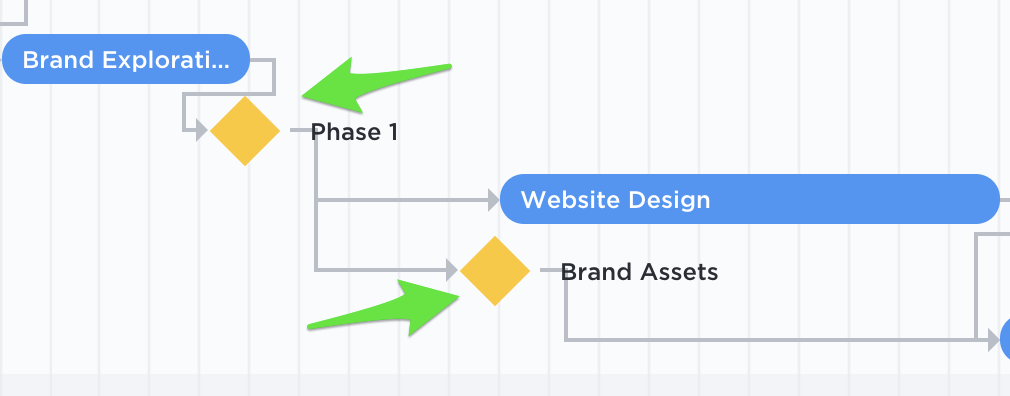
أمثلة على معالم المشروع في ClickUp
بغض النظر عن نوع طريقة العرض التي اخترتها، لن تفوتك أبدًا لحظات المعالم البارزة في مشروعك. قم بتحويل أي مهمة إلى معلم بارز بنقرة زر واحدة وقم بتصفية المعالم البارزة للتحقق من وقت إنجازها في السنة التقويمية.
ClickUp للموارد البشرية وفرق الإدارة ### ClickUp لفرق الموارد البشرية والإدارة
بالنسبة لفرق الموارد البشرية، تقدم ClickUp أداة مثالية أداة تتبع إنتاجية الموظفين . بالنسبة لفرق الإدارة الأخرى، يعد ClickUp أداة مثالية برنامج مشاركة الموظفين .
تقوم فرق الموارد البشرية بتصور سير العمل وترتيب الموارد بسرعة باستخدام طرق عرض النموذج والجدول وعبء العمل.
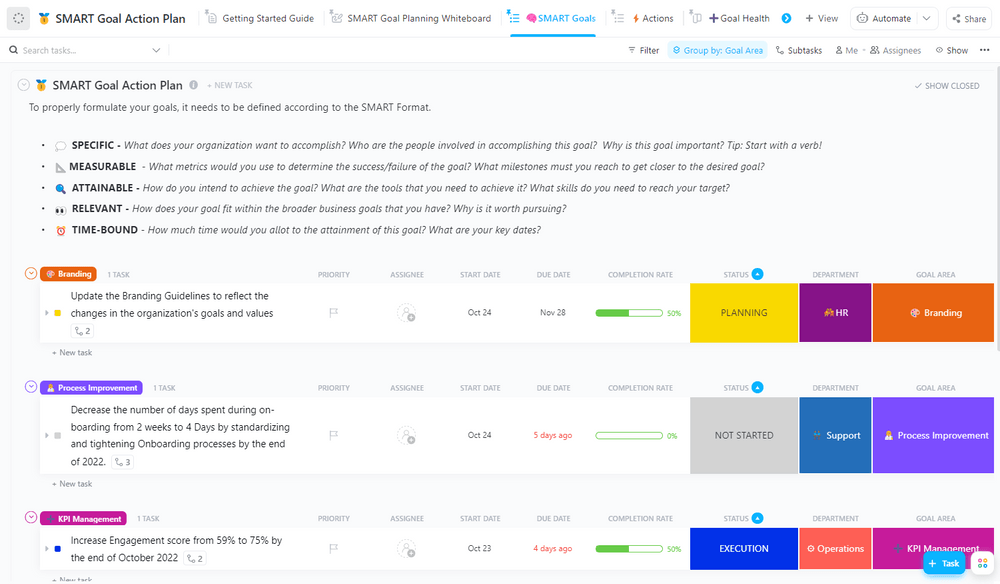
باستخدام قالب خطة عمل الأهداف الذكية SMART، يمكنك ضمان متابعة أهدافك من خلال عرض مرئي للقائمة لإبقاء كل شيء منظمًا وعلى المسار الصحيح لوحة تحكم ClickUp نظرة شاملة على المعالم الرئيسية والوصول عالي المستوى إلى مؤشرات الأداء الرئيسية والأهداف التي يتعين على الفريق تحقيقها. مهما كانت هدف الموارد البشرية هو أن لوحة التحكم تسمح للجميع بتتبع التقدم المحرز وأن يكونوا على نفس الصفحة.
ClickUp هي أيضًا منصة شاملة لتجربة الموظفين لفرق الإدارة لتصميم خطة تطوير الموظفين و أنشطة مشاركة الموظفين . تقوم فرق الإدارة بتنفيذ هذه الخطط للحفاظ على تركيز الموظفين والحصول على أقصى قدر من مساهمتهم.
تعمل ClickUp كمنصة شاملة تمكّن فريق القيادة من
- الحفاظ على التحفيز العالي للموظفين
- اكتشاف المواهب المستقبلية وتطويرها
- تحسين الاحتفاظ بالموظفين
للمضي قدمًا، يقوم فريق الموارد البشرية بتخصيص الخطة من خلال إضافة طرق عرض وحقول وحالات مخصصة وتقسيم الأهداف الشاملة إلى مهام أصغر يمكن إدارتها لفرق العمل المختلفة.
انقر فوق القوالب لإدارة مراجعات الأداء
على الرغم من أن ClickUp ليس من الناحية الفنية برنامج مراجعة الأداء ، تجعل قوالب مراجعة الأداء من ClickUp إعداد عمليات مراجعة الأداء أمراً سهلاً للغاية. قوالب ClickUp هو اختصار لتنفيذ الأمور بشكل أسرع مع تصميمات جاهزة للاستخدام. إليك بعض الأمثلة على قوالب ClickUp التي ستكون مفيدة للغاية في تخطيط برامج مكافآت الموظفين.
قالب الأهداف السنوية
نموذج قالب الأهداف السنوية يتيح لك تحديد الأهداف السنوية، وتقسيمها إلى مهام أصغر، وتتبع التقدم المحرز في كل مشروع. قم بتعيين المهام وتحديد الأولويات وإبقاء الجميع مسؤولين عن دورهم. يرجع الموظفون إلى هذا النموذج لضمان تقدمهم في الاتجاه الصحيح.
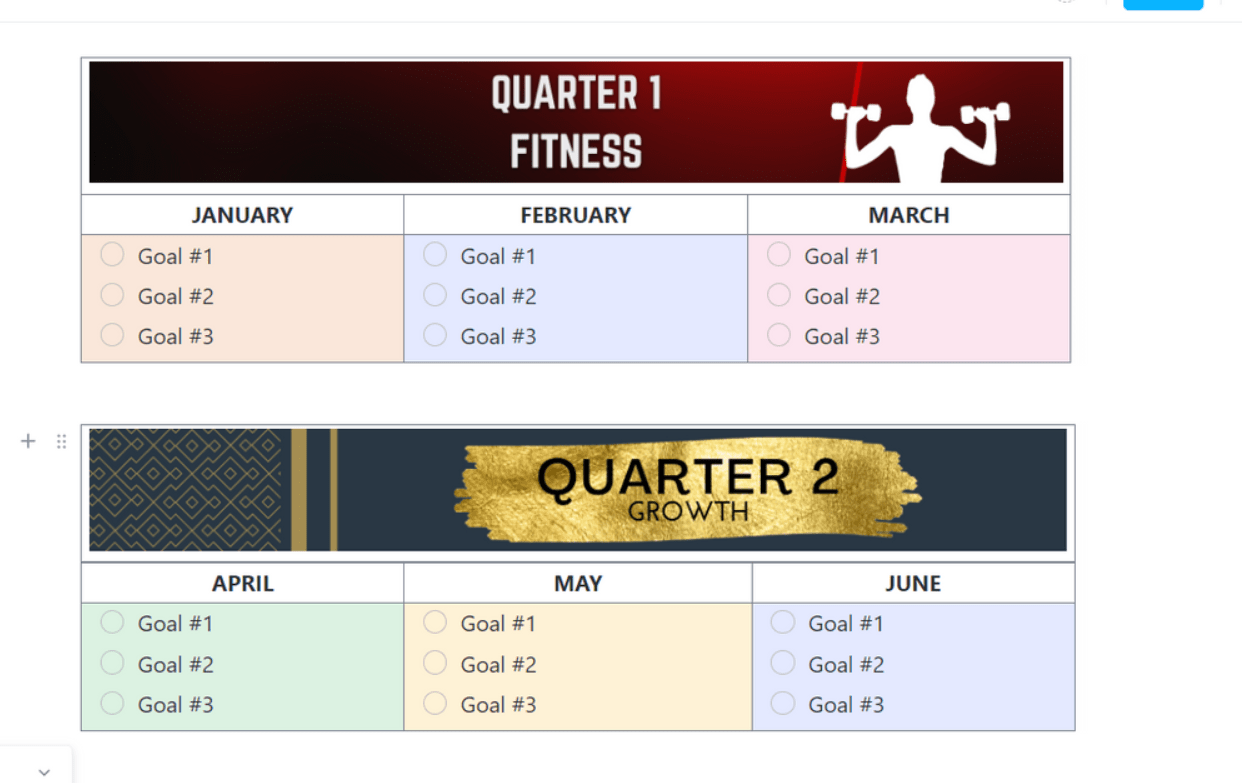
استخدم قالب أهداف ClickUp السنوية لتحديد الأهداف السنوية، وتقسيمها إلى مهام يسهل إدارتها، وقياس التقدم المحرز فيها
قالب تقرير الأداء
تستخدم فرق الموارد البشرية نموذج تقرير الأداء لتتبع أداء الفريق في الوقت الفعلي وتحليل الاتجاهات باستخدام التصورات والرسوم البيانية. أفضل ما في هذا القالب هو أنه يسمح بمراقبة مؤشرات الأداء الرئيسية في الوقت الفعلي وإنشاء تقارير آلية دون بذل جهد إضافي لمشاركتها مع أصحاب المصلحة.
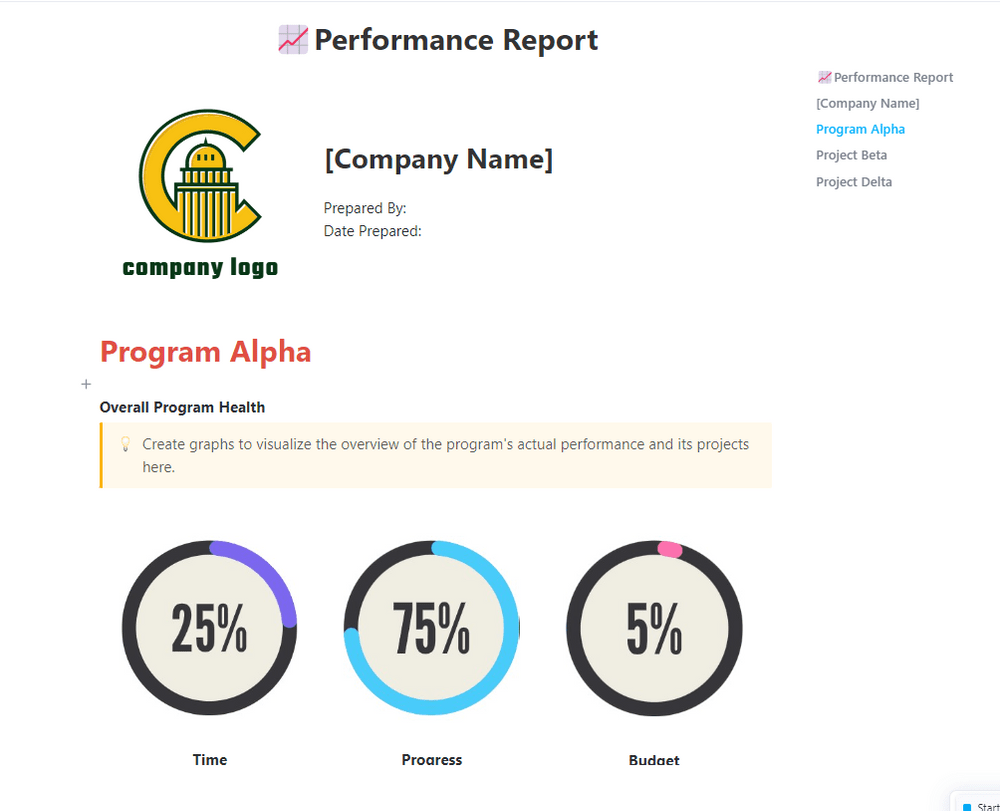
ضع كل شيء يتعلق بأهداف فريقك وأدائه في هذا القالب المفيد
قالب خطة تطوير الموظفين
يحتوي برنامج تقدير الموظفين على العديد من العناصر الأساسية. قالب خطة تطوير الموظفين في ClickUp يساعدك على تتبع نمو موظفك من خلال الحالات المخصصة، وطرق العرض المخصصة، وإدارة المشروع من خلال إمكانات تتبع الوقت.
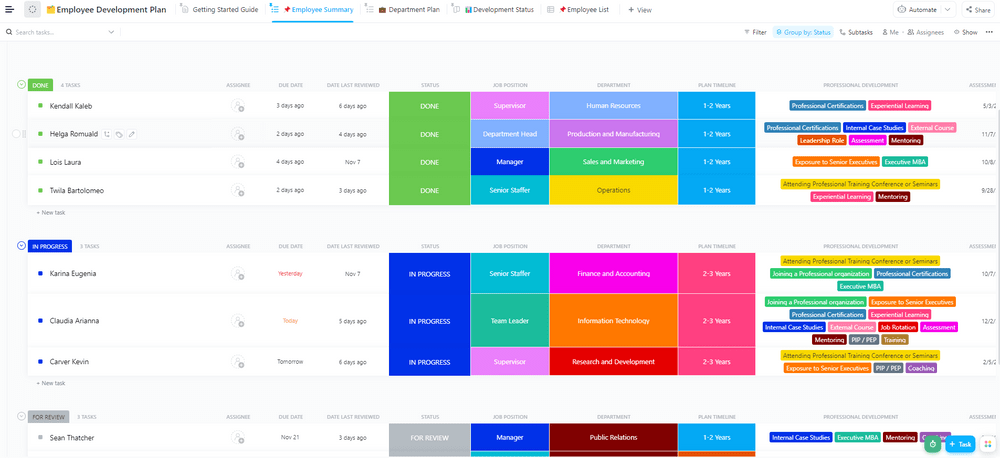
زوِّد الموظفين بالمعلومات والمهارات اللازمة للأدوار/المسؤوليات الجديدة باستخدام نموذج قائمة خطة تطوير الموظفين
إن مفتاح نجاح برنامج مشاركة الموظفين ومكافأتهم هو تحفيزهم بناءً على تقدمهم ومساهمتهم في تحقيق أهداف الشركة.
قالب المعالم الرئيسية
نموذج قالب المعلم طريقة سهلة لتصور المعالم الرئيسية في المشروع. وهذا يعطي قادة الفريق نظرة عامة سريعة على المعالم الهامة في المشروع. يتم استخدام الدروس المستفادة للتنبؤ بالجدول الزمني للمشاريع المستقبلية.

ابدأ باستخدام هذا القالب لتوثيق معالم مشروعك بطريقة تعاونية وممتعة وجذابة بصريًا، حتى تظل على اطلاع على المعالم المهمة
قم بتشغيل برنامج مكافآت موظفيك الأول باستخدام ClickUp
أنت بحاجة إلى تعاون الجميع لإعداد برنامج مكافآت الموظفين وتشغيله بنجاح. يحتاج قادة الموارد البشرية والإدارة إلى مظهر مناسب للمبتدئين مثل ClickUp لبدء العمل.
عند تشغيل برنامج مكافآت وتقدير الموظفين لأول مرة لتحسين مشاركة الموظفين، فإن ClickUp هو الخيار الأفضل. حتى فريق الموارد البشرية لديك يمكنه إعداد نظام المكافآت الأساسي للموظفين وتتبع نجاح البرنامج.

استخدم ClickUp Docs لإدارة مستندات الموارد البشرية المهمة وتعزيز تعاون الفريق
ابدأ بإعداد المهام وتعيين التعليقات كعناصر إجراءات. أضف إرشادات لبرامج المكافآت الخاصة بك على مستندات ClickUp وربطها بسير عملك الحالي. استخدم السبورة لتبادل الأفكار وإضافة ملاحظات حول برامج المكافآت الخاصة بشركتك.
ابقَ على المسار الصحيح مع الأهداف، وحدد جداول زمنية واضحة وقابلة للقياس، وقم بأتمتة تتبع التقدم لكل من الأهداف طويلة الأجل وقصيرة الأجل .
تصور التقدم الذي يحرزه كل موظف في الوقت الفعلي من خلال خاصية ClickUp القابلة للتخصيص بالكامل لوحات المعلومات واحصل على رؤى ثرية في لمحة سريعة.
تكامل ClickUp مع برنامج مراقبة الموظفين يمنح المديرين معلومات في الوقت الفعلي لتقييم أداء الموظفين. توفير الوقت الذي كان سيذهب إلى تصدير البيانات من مصادر مختلفة إلى برامج المكافآت والتقدير الخاصة بك.
تُعد قوالب مراجعة الأداء المبنية مسبقاً موفرة للوقت لفريق الموارد البشرية المشغول. كل ما عليك فعله هو توصيل وتشغيل متطلباتك في القالب للبدء.
أصبح إنشاء برنامج مكافآت الموظفين أسهل من أي وقت مضى! اشترك في ClickUp مجانًا وأنشئ أول نظام مكافآت للموظفين.

